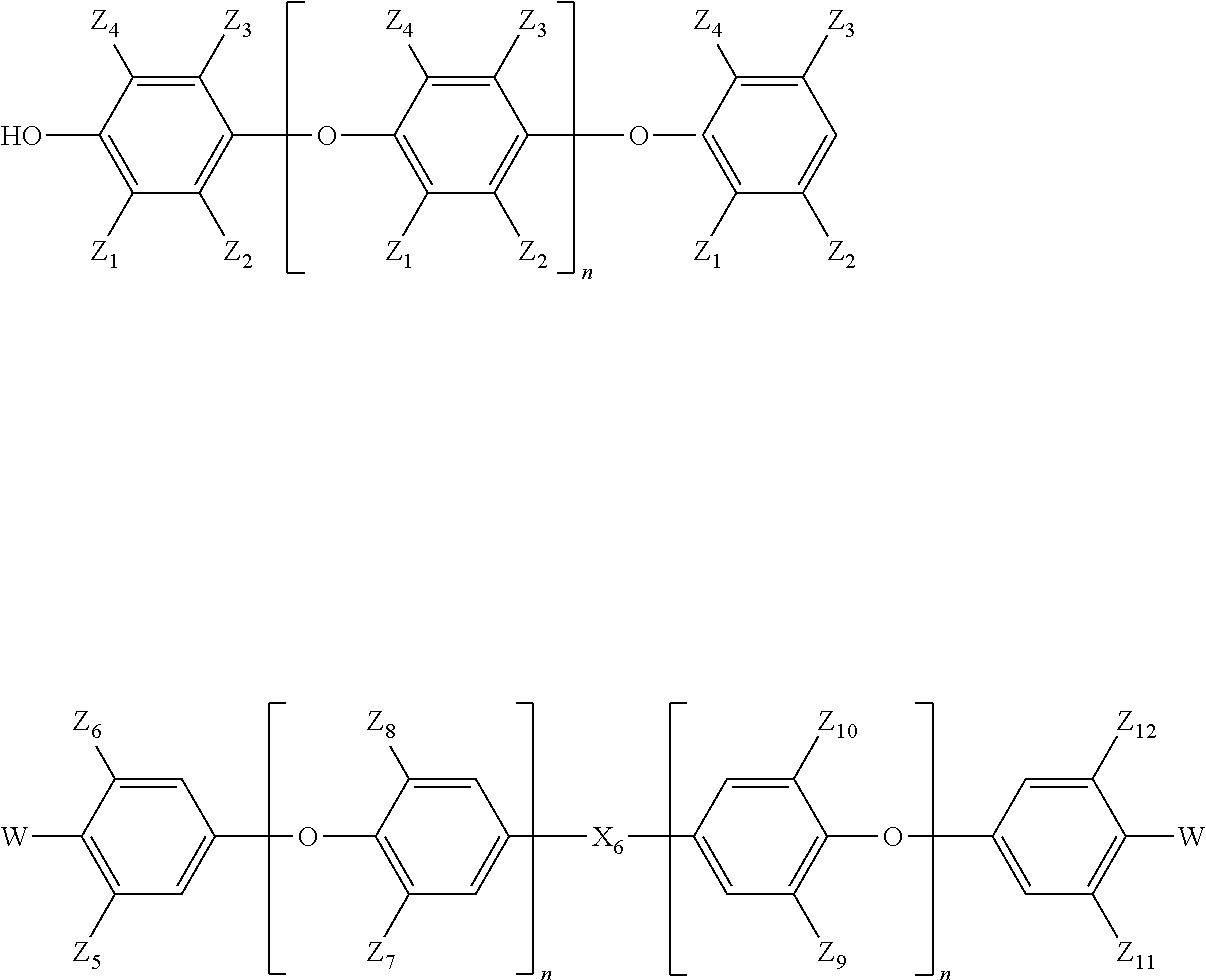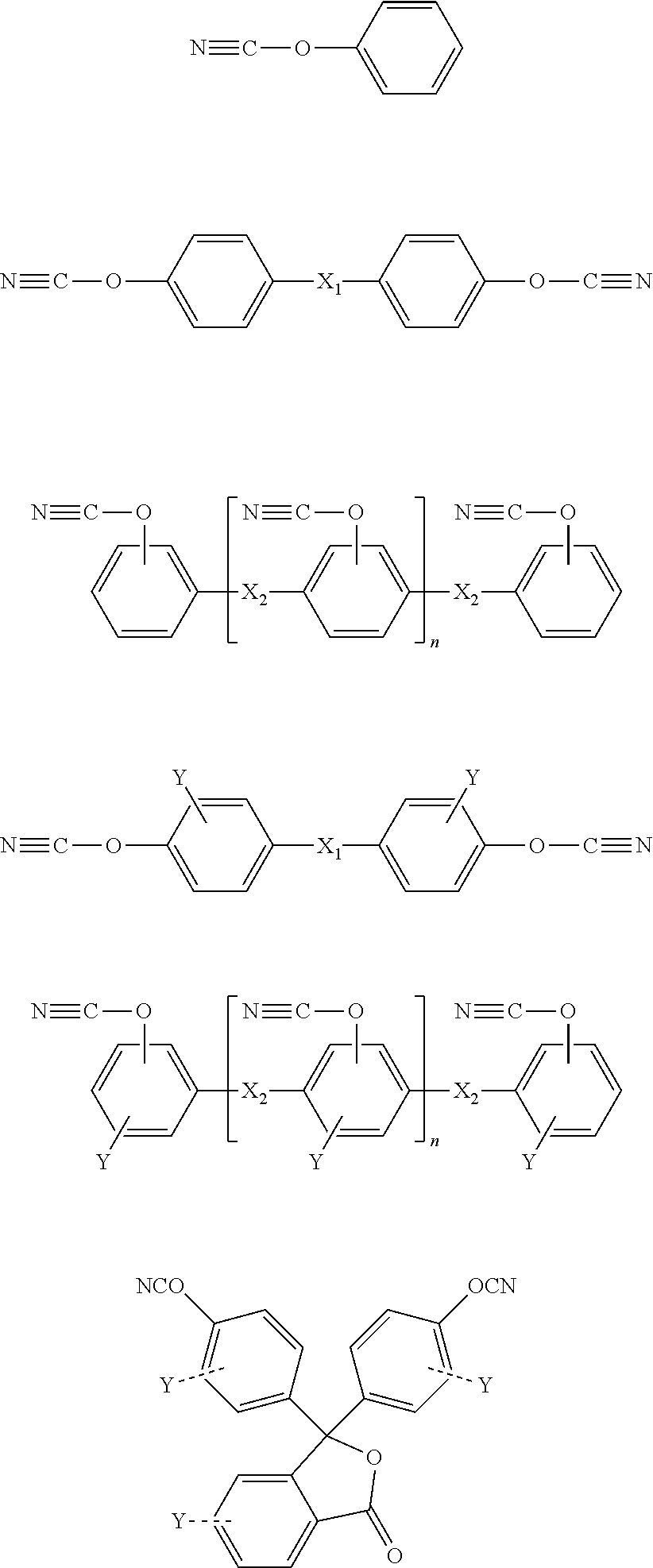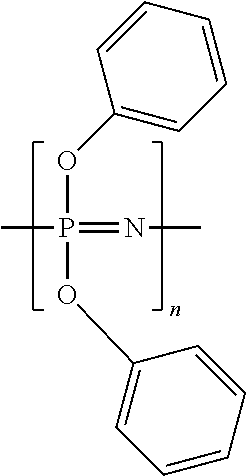Low dielectric halogen-free resin composition and circuit board using the same
a technology of halogen-free resin and composition, which is applied in the direction of printed circuit aspects, transportation and packaging, chemical instruments and processes, etc., can solve the problems of most hazardous halides, halides with a large specific gravity, and corrosion of fine circuits, and achieve low thermal expansion coefficient, low dielectric properties, and flame retardancy.
- Summary
- Abstract
- Description
- Claims
- Application Information
AI Technical Summary
Benefits of technology
Problems solved by technology
Method used
Image
Examples
manufacturing example 1
[0065]Put 260 g of the phosphazene (compound A, SPH-100) having a hydroxyl group, 150 g of 4-chlro-methyl styrene (CMS-P), and toluene in a reactor. Set the temperature in the reactor to 50˜80° C. Start blending the aforesaid chemicals in the reactor. In the course of the blending process, the solid-state phosphazene compound having a hydroxyl group dissolves and thus changes to a liquid state. Then, add 40 g of sodium hydroxide and 1 g of tetrabutylammonium iodide to the reactor and keep blending the chemical therein for 6 hours. Afterward, rinse the chemicals in the reactor with methanol to thereby obtain a vinyl benzyl ether phosphazene (compound B). The vinyl benzyl ether phosphazene falls into the category of a vinyl phosphazene, and it appears in the form of a brown solution (vinyl benzyl ether phosphazene and toluene) of 150 g.
[0066]The method for testing the aforesaid vinyl phosphazene involves the use of FTIR, as shown in FIG. 1, FIG. 2 and FIG. 3. FIG. 1 shows a FTIR spect...
embodiment 1-1 (
E1-1)
[0068]A resin composition, comprising ingredients as follows:
(A) 100 parts by weight of SA-9000 (polyphenylene oxide resin);
(B) 15 parts by weight of BMI-2300 (maleimide resin);
(C) 10 parts by weight of Ricon257 (styrene butadiene divinyl benzene terpolymer);
(D) 10 parts by weight of BTP-6020S (cyanate ester resin);
(E) 50 parts by weight of SPB-100 (phosphazene);
(F) 125 parts by weight of fused silica (inorganic filler);
(G) 200 parts by weight of toluene (solvent);
(H) 3 parts by weight of 25B (curing accelerator).
embodiment 1-2 (
E1-2)
[0069]A resin composition, comprising ingredients as follows:
(A) 100 parts by weight of SA-9000 (polyphenylene oxide resin);
(B) 15 parts by weight of BMI-2300 (maleimide resin);
(C) 10 parts by weight of Ricon257 (styrene butadiene divinyl benzene terpolymer);
(D) 10 parts by weight of BTP-6020S (cyanate ester resin);
(E) 50 parts by weight of SPH-100 (phosphazene having a hydroxyl group);
(F) 125 parts by weight of fused silica (inorganic filler);
(G) 200 parts by weight of toluene (solvent);
(H) 3 parts by weight of 25B (curing accelerator).
PUM
| Property | Measurement | Unit |
|---|---|---|
| Percent by mass | aaaaa | aaaaa |
| Percent by mass | aaaaa | aaaaa |
| Percent by mass | aaaaa | aaaaa |
Abstract
Description
Claims
Application Information
 Login to View More
Login to View More - R&D
- Intellectual Property
- Life Sciences
- Materials
- Tech Scout
- Unparalleled Data Quality
- Higher Quality Content
- 60% Fewer Hallucinations
Browse by: Latest US Patents, China's latest patents, Technical Efficacy Thesaurus, Application Domain, Technology Topic, Popular Technical Reports.
© 2025 PatSnap. All rights reserved.Legal|Privacy policy|Modern Slavery Act Transparency Statement|Sitemap|About US| Contact US: help@patsnap.com



